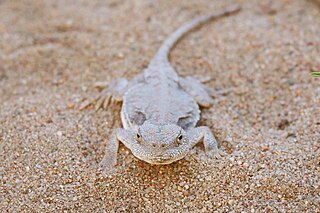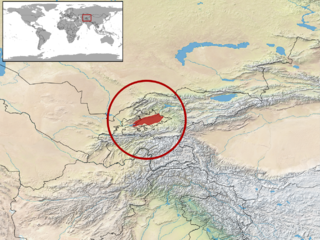
Phrynocephalus is a genus which includes 33 species of small and medium-sized agamid lizards, commonly called toadhead agamas or toad-headed agamas, that inhabit open arid and semiarid environments of Asia and Eastern Europe. The systematics of this genus are very complicated with many controversial points of view about the unclear phylogeny of this group. All representatives of this genus have adopted the so-called "sit and wait" hunting strategy and they actively use visual orientation when watching for food. In general, the ecological niche and role of Phrynocephalus species in lizard communities of arid environments of Asia are poorly studied, but seem to be similar to that of Phrynosoma, Cophosaurus, Holbrookia, Uta, and Sceloporus in the New World, as well as Moloch in Australia.
The reticulated toad-headed agama is a species of agamid lizard found in Central Asia and West Asia.

Phrynocephalus theobaldi is a species of lizard in the family Agamidae. The species is endemic to Asia.

The Agaminae are a subfamily of reptiles in the family Agamidae.

Phrynocephalus mystaceus, also known as the secret toadhead agama and toad-headed agama, is a species of agamid lizard. It is found in southern Russia, Kazakhstan, and northwestern China (Xinjiang) and southward to northern Iran, Afghanistan, Turkmenistan, Tajikistan, Kyrgyzstan, and Uzbekistan.

Phrynocephalus persicus, commonly known as the Persian toad-headed agama, is a small diurnal desert lizard of the family Agamidae. It is the westernmost representative of the Central Asian genus of toad-headed agamas Phrynocephalus and is only known from deserts and semideserts of Iran and possibly Azerbaijan.

Phrynocephalus horvathi is a small diurnal desert lizard in the family Agamidae. It is endemic to the valley of the Aras River and considered Critically Endangered.
Phrynocephalus clarkorum, also known commonly as the Afghan toad-headed agama and Clark's toad-headed agama, is a species of lizard in the family Agamidae. The species is native to parts of Central and South Asia.

Phrynocephalus guttatus, also known commonly as the spotted toadhead agama, the Saissan toad-headed agama, the Central Asian toadhead agama, and Salensky's toadhead agama, is a species of lizard in the family Agamidae. The species is native to southeastern Europe and western Asia. There are five recognized subspecies.

Phrynocephalus helioscopus, the sunwatcher toadhead agama, Fergana toad-headed agama, or sunwatcher, is a species of agamid lizard found in Kazakhstan, S Russia, Turkmenistan, Uzbekistan, Kyrgyzstan, Tajikistan, Turkey, Iraq, China, Mongolia, and Iran.

Phrynocephalus interscapularis, Lichtenstein's toadhead agama, is a species of agamid lizard found in Turkmenistan, Kazakhstan, Uzbekistan, Iran, and Afghanistan.

Przewalski's toadhead agama, also known as Tsarewsky's toadhead agama, or Steindachner's toadhead agama, is a species of agamid lizard found in China and Mongolia. This species was named after Nikolay Przhevalsky, a Russian Imperial geographer and explorer of Central and East Asia.

Phrynocephalus scutellatus, the gray toadhead agama, is a species of agamid lizard found in Iran, Afghanistan, and Pakistan.

Phrynocephalus strauchi, Strauch's toad agama, is a species of agamid lizard found in Tajikistan, Kyrgyzstan, and Uzbekistan.
Phrynocephalus hispidus, the Dzhungar variegated toadhead agama, is a species of agamid lizard found in China.
Phrynocephalus kulagini, Kulagin's variegated toadhead agama, is a species of agamid lizard found in Mongolia and Russia.













